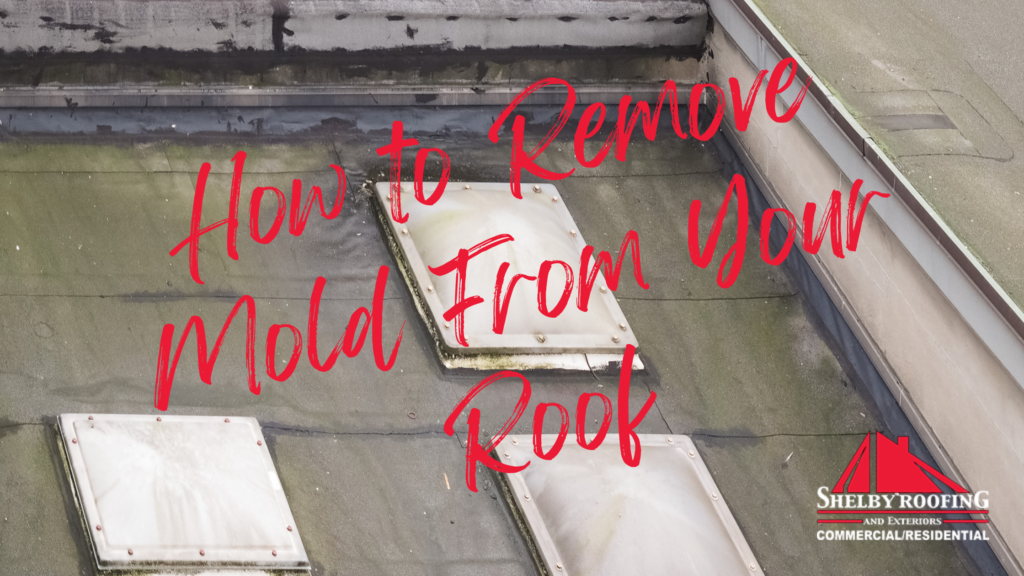How to Remove Mold from Your Roof in Arnold, Imperial, Oakville, Fenton, and St. Louis
If you have noticed black mold-like stains and streaks on your residential or commercial property roof, it is important to begin taking steps to have the blue-green algae removed. While it is believed that the appearance of mold is most common on light-colored asphalt shingles, it can grow on all shingle colors and nearby siding based on the surrounding environmental conditions. Mold needs warmth, humidity, and moisture to thrive and unfortunately Missouri and Illinois have humid subtropical and continental conditions that make perfect breeding grounds.
Along with limiting the property’s curb appeal, if not removed in a timely manner, mold can potentially impact your roof’s lifespan, reduce your home’s efficiency, and lead to costly repairs in the future. Mold can also cause respiratory conditions and other health issues from the spores entering your home through the air ducts and air conditioning system or tracked inside from walkway buildup. To get started, here is how you can DIY the removal of mold on your roof and how hiring a professional roofing contractor can help you tackle and prevent future mold problems.
How to Remove Mold from Your Roof
If you are already considering replacing your home’s roof or increasing the value of your home, it is recommended that you opt for darker shingles to disguise the look of mold stains and streaks or shingles with copper granules that prevent mold growth.
However, if you simply notice a few affected areas on the shingles and siding, then cleaning the mold yourself with a simple, at-home solution should be your first step. There are two DIY solutions that you can use to kill mold, remove any discoloration, improve exterior aesthetics, and protect against additional damage. The most common solution is creating a 50:50 chlorine bleach and hot water solution, while tougher jobs may require the use of trisodium phosphate with a 1 cup TSP to 1 gallon of water ratio.
Using a ladder, climb up and inspect the roof to identify where the mold, mildew, algae, lichen, or moss build-up is prevalent. Then pour your chosen solution mix into a garden sprayer and carefully spray the affected shingles from the bottom to the top of your roof. Then, leave the solution on the roof’s surface for 15 -20 minutes and rinse thoroughly with water. For algae, you will need to gently scrub the area and do a second bleach-water treatment.
For both options, be sure to wear proper safety equipment to protect yourself from harmful exposure. This includes safety goggles, a full-face respirator mask, and waterproof gear (such as a raincoat and gloves) to prevent exposure to your eyes, lungs, and skin.
It is also important to remember to not use a pressure washer to prevent shingle damage and to water surrounding landscape to prevent bleach toxicity in your plant life. Store bought pressure washers often only have a single, high-power setting that is meant to be used for extreme removal of dirt, grime, and other environmental elements, which can result in shingles being damaged or lifted off the roof. If you feel a pressure washer is necessary, speak with a roofing contractor who has a pressure washer or another method that is right for the job.
How to Prevent from Returning
If you have noticed that the mold is becoming a continuous issue, there are some long-term prevention methods you can consider with the help of a roofing professional.
As noted, adding shingles with copper granules is one option and a similar choice is adding a 6-inch strip of zinc or copper underneath new shingles that are closest to the roof’s peak, leaving a couple inches of the roof’s lower edge weather-exposed for the best results. Both options have natural antimicrobial properties that help to naturally stave off mold production. So, making these improvements during a standard roof repair will help kill algae and moss growth during heavy rains that wash down the metal molecules.
Another option is to waterproof your roof to prevent the collection of moisture and various growths. This can be done by a trusted roofing contractor in just a few hours, who will apply an acrylic asphalt sealant to your existing roof to add a protective layer to the shingles and keep your roof safe from water damage. This is best done after the roof has been cleaned with one of the DIY solutions above.
With this, be sure to have your roof inspected 1-2 times per year to prevent expensive and harmful damage to your roof due to mold. A trusted roofing contractor can help you answer important questions, like:
- Are there any signs that the roof’s upper layers are pulling away or delaminating?
- Are there any signs of rips, detached seams, or tears?
- Is the roof free of pooling water?
- Is the roof draining properly and are there any issues with the drains or scuppers?
- Can any water stains or streaking be seen on the interior ceilings, inside exterior walls or windows, or decking?
These questions can help you identify the extent of your roof’s mold problem and what steps you need to take next. After all, maintaining the integrity of your home’s roof is vital to the health and comfort of your family, as well as the preservation of your belongings and furniture. Even small areas of mold growth can cause long-term issues to your health and home, while also reducing your home’s curb appeal.
Need help cleaning the mold off your roof? Have questions about the best materials to prevent mold for your roof replacement? Shelby Roofing & Exteriors is a trusted and reliable company that provides exceptional roof cleaning, repair, and installation services for residential and commercial properties. Contact us to discuss your roofing needs, whether in the St. Louis metropolitan area, Illinois, or surrounding areas at (636) 942-2300 for a free, comprehensive estimate or visit us on Facebook.






